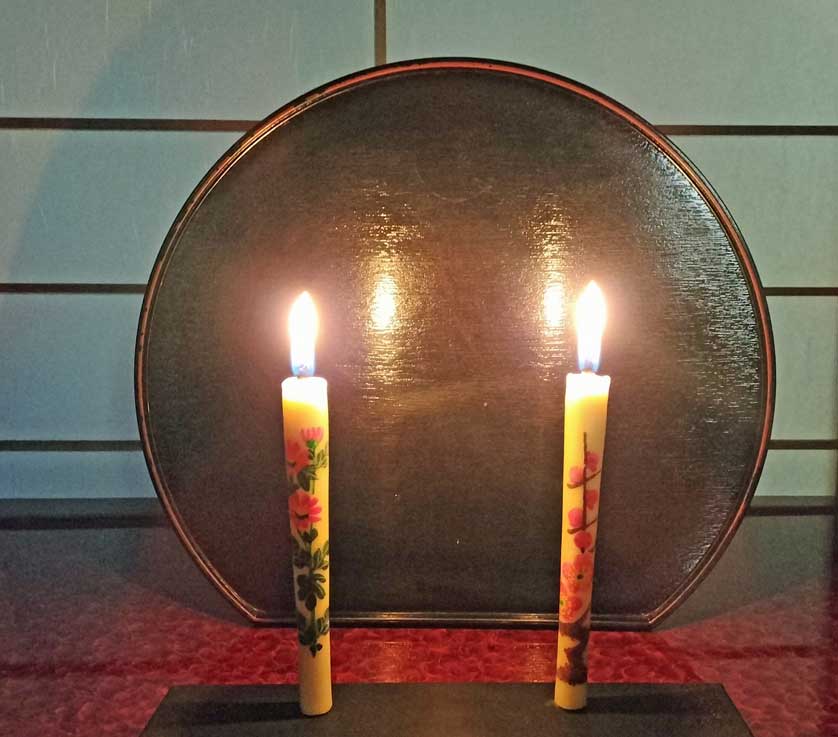Aizuwakamatsu Hand Painted Candles 会津若松 絵ろうそく
 |
| Aizwakamatsu e - rousoku |
Japan's Tensho Period (1573-1592) was, like most of the 16th century in the country, a period of wars. Oda Nobunaga just started out to unify the country, bloodily battling scores of local rulers.
At the same time, the late 16th century was a period of cultural refinement. Not only at the Imperial Court but across the country. Local daimyo (feudal rulers) competed in the arts as much as on the battlefield. It was the time when the Tea Ceremony became codified, the time when the finer points of ikebana (flower arrangement) became strictly regimented, the time when kodo (the Way of Incense) became an art.
Gamo Ujisato (1556-1595) was a clan chief and warrior fighting for Oda Nobunaga and his successor Toyotomi Hideyoshi. For his exploits on the battlefields, Hideyoshi appointed him as the ruler of the Aizu domain, in the west of today's Fukushima Prefecture.
Newly residing in Tsuruga Castle in the center of the regional capital Aizuwakamatsu, Gamo finally found time to concentrate on the arts. Gamo had already been one of Japan's most celebrated masters of the Tea Ceremony but it was his decree demanding the production of hand-painted candles that still makes him a popular figure in Aizuwakamatsu today.
Supported by the daimyo succeeding Gamo, the tradition of producing hand-painted candles has been flourishing in Aizuwakatsu since the time of Gamo's decree.
Gamo ordered the production of candles with artfully designed floral motifs. The floral motifs developed as response to Gamo's order are still the motifs on Aizuwakamatsu painted candles today. They are the perhaps most popular souvenirs bought in the city by visitors in the know.
 |
| Tsuruga Castle, Aizuwakamatsu, Japan |
Japanese Candles
Regardless of the elaborate paintings adorning them, even a cursory look at the candles themselves makes clear that they are very different from Western candles. Those are Wa-Rousoku, Japanese candles.
Japanese candles predate Gamo's order by centuries. They served as the main source of light at night even in poor households.
Western candles in the middle ages and beyond were typically made of tallow, hardened beef fat, a byproduct of the Western meat-eating culture.
In Japan, strict interpretations of Buddhist teachings prohibited the consumption of four-legged animals from the 700s on until the early 1870s.
That meant that tallow was unavailable.
Beekeeping was also not a popular feature in old Japan, thus bee wax candles were unknown.
Instead, the ever useful and very versatile lacquer tree (Toxicodendron vernicifluum) was employed. While the sap of the tree could be used to create beautiful lacquerware, the oil-rich fruits could be cooked and pressed, resulting in a hard, waxy residue known as mokuro (Japan Wax).
That mokuro wax is what traditional Japanese candles are made of.
 |
| Aizuwakamatsu hand-painted candles |
The Wick
The wicks of Western candles were commonly made of flax, later it became cotton.
Traditional Japanese wicks are a bit more complicated. They are made of washi paper infused with the pith of rushes (Juncaceae), a common plant in Japan. The wick is stabilized by silk floss.
Typically, the lower part of a Japanese candle is hollowed out, making it easy to place the candle on a nail or the thorn of a traditional candle holder.
It was those wa-rousoku candles Gamo Ujisato had in mind when he ordered candles to be painted.
 |
| Hoshiban candle store in Aizuwakamatsu |
Hoshiban Candle Store
The historic Aizuwakatmatsu neighborhood of Nanukamachi, a short bus ride northwest of (reconstructed) Tsuruga Castle is still a center for the production of hand-painted (e-rousoku) candles.
The perhaps most famous of the candle stores located there, is the Hoshiban. It's situated in a historic building though the building is most likely not as old as the business itself.
The Hoshiban started out in 1772 as a direct supplier to the daimyo at Tsuruga Castle. Run continuously since then by the same family over many generations, the Hoshiban is the perhaps most authentic of all the candle shops in Aizuwakamatsu today.
Enter the store and take a look. There are the shelves with the traditional hand-painted candles. Intricately painted candles in many sizes ranging from very large beauties only the richest of Buddhist temples might want to use for special ceremonies to small candles intended for the purchase by the curious visitor.
Other shelves feature fantastically shaped creations, barely passing for a candle if there wouldn't stick a small wick out of them.
 |
| Hand painted candles from Aizuwakamatsu |
Those are made of paraffin, the sales lady quickly points out. Paraffin being the oil / coal based substance almost all modern candles are made of. Cheap stuff, invented in Germany in 1830 and put to industrial use in England in the 1850s. Paraffin is easy to work with, hence those strange creations on display.
But main and center are the e-rousoku, the hand-painted traditional wa-rousoku candles.
Take your time choosing. While you are at the store, the master of candle painting might just sit down close to the street view window, the place with the brightest light, and start painting candle by candle by hand.
 |
| Window of the Hoshiban candle store, Aizuwakamatsu. The master is busy painting candles right behind the window |
Buying Hoshiban Aizuwakamatsu Candles
Aizu, the area around Mount Bandai and Inawashiro Lake offers quite some stunning landscape. Aizuwakamatsu adds plenty of historical city settings.
Higashiyama Onsen, a 30-minute bus ride from central Aizuwakamatsu, is one of the most beautiful hot spring resorts in northern Japan.
While there, make sure to visit the Hoshiban candle shop!
Alternatively, you can of course buy original Hoshiban hand-painted candles right at your finger tip here at Goods from Japan.
Purchase Japanese candles from GoodsFromJapan.
 |
| Aizuwakamatsu e-rousoku in a butsudan (Buddhist house altar) |
Related
Daruma Dolls - History & Symbolism
by Johannes Schonherr
 |
| Sign outside the Hoshiban candle store, Aizuwakamatsu |
© GoodsFromJapan.com

